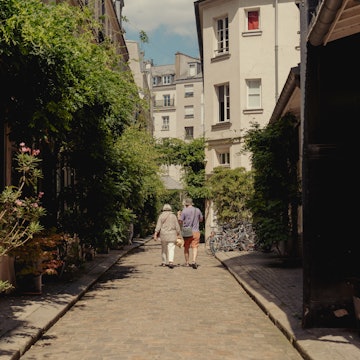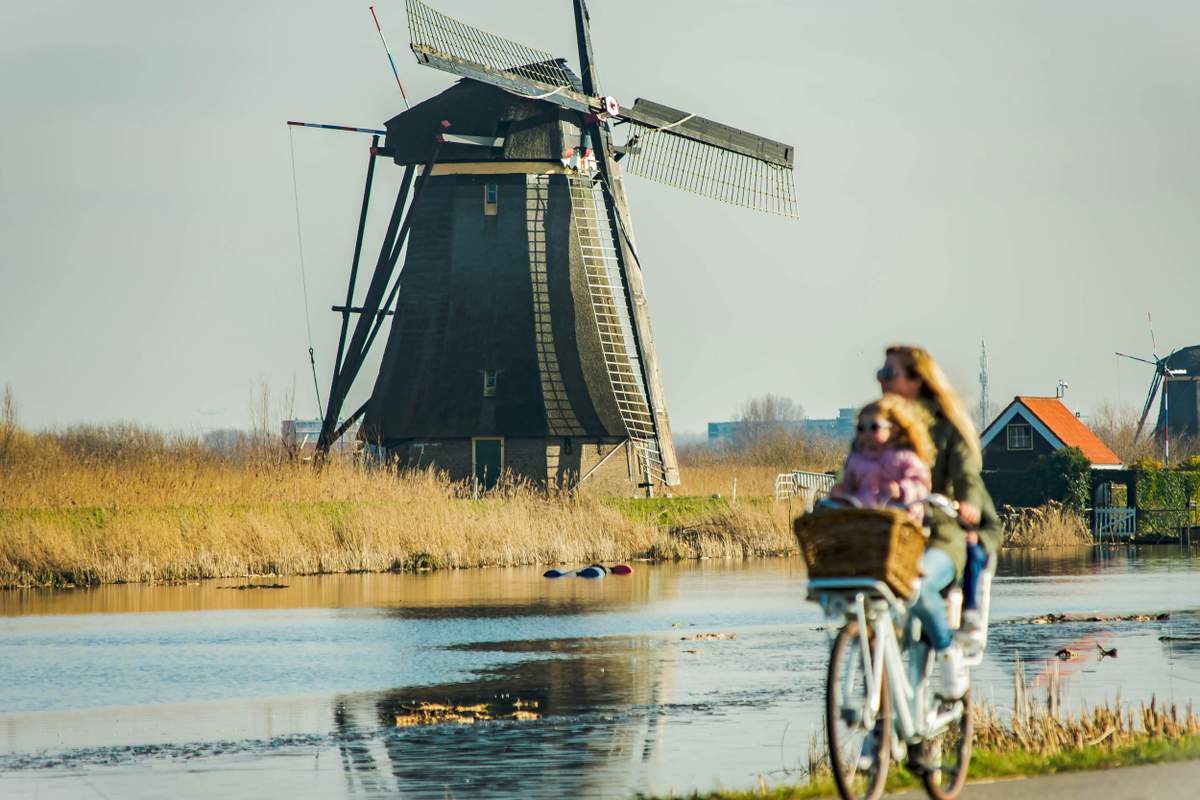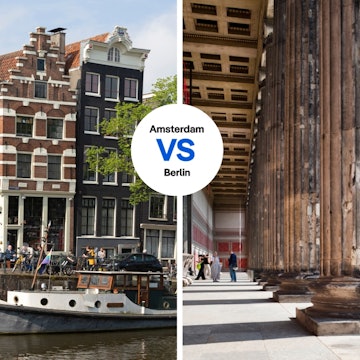

Tulips in bloom near Lisse, the Netherlands. JacobH/Getty Images
At the center of three vast bulb-growing areas, Amsterdam and its surrounds transform like a larger-than-life coloring book when tulips, in a profusion of red, yellow, orange, pink, purple and white hues, bloom en masse in spring. Flower fields fan out around the Dutch capital in the provinces of Noord-Holland (North Holland), Flevoland and Zuid-Holland (South Holland), where the beautiful Bollenstreek (bulb region) unfolds between the grand cities of Leiden and Haarlem, coastal dunes and charming villages.
During tulip season, the national flower splashes color through Amsterdam’s parks, canals and city streets, with magnificent displays further afield including the spectacle at Keukenhof Gardens, along with cycling routes through the bulb fields, and events including a flower-festooned Bloemencorso (Flower Parade).
This glorious time of year gets busy with visitors, so planning ahead is vital. Here’s how to make the most of the short-lived but spectacular season.

What is the history of tulips in the Netherlands?
The Netherlands is the world’s largest producer of bulbs – some 8.5 billion per year, a mammoth 85% of the international trade – cultivated by more than 1500 bulb growers in flower fields so immense they’re visible from space.
Yet the country’s emblematic blooms actually originated as wildflowers in Central Asia’s mountains, steppes and deserts, and were first cultivated by the Turks: “tulip” derives from tülbend, the Turkish for turban, which tulips resembled. In the mid-16th century, the Habsburg ambassador to Istanbul brought bulbs back to Vienna, where they were propagated by imperial botanist Carolus Clusius. When Clusius became director of Leiden University’s Hortus Botanicus Leiden (the Netherlands’ – and one of the world’s – oldest botanical gardens), he found the maritime climate and sandy-clay polder soil perfect for tulip cultivation. Exotic frilled, flame-streaked cultivars now known as Rembrandts featured in 17th-century paintings, which helped fuel one of the world’s earliest investment booms (at its height a single tulip cost more than an Amsterdam canal house) from 1636 to 1637, when it abruptly went bust.
Even after the heady days of tulip mania, enthusiasm for the flower continued to thrive. Today, tulips make up the majority of the Netherlands’ bulb production, which also includes crocuses, daffodils, hyacinths, lilies, gladioli and dahlias.

When is the best time to go?
Tulip season starts on Nationale Tulpendag (National Tulip Day). On the third Saturday in January, the expansive lawns of Amsterdam’s Museumplein, next to the Van Gogh Museum and Rijksmuseum, are carpeted with 200,000 tulips planted by growers association Tulpen Promotie Nederland (Tulip Promotion Netherlands), with a viewing platform over the flowers, a dweilorkest (traditional Dutch brass band) playing popular songs like "Tulpen uit Amsterdam" (Tulips from Amsterdam), and the opportunity to pick a free bouquet.
It’s not until mid-March that Keukenhof’s monumental gardens open for the season, and bulb fields burst into color. Weather and conditions vary from year to year, so flowering can start earlier and/or finish later (there are also early and late tulip varieties).
April is the prime time to catch tulips in full bloom, along with lively events. Amsterdam’s Tulp Festival, with flower beds, floating flowers in ponds and waterways, and flower-lined routes through the city, runs for the entire month.
An annual highlight is mid-April’s five-day Bloemencorso (Flower Parade). Celebrations start in the Bollenstreek village of Noordwijkerhout, where you can see the ornate floats being painstakingly pinned with colorful flowers during Decoration Days from Wednesday to Friday morning, and catch the Friday evening illuminated parade. On Saturday, the main 42km (26-mile) parade winds from Noordwijkerhout to the historic city of Haarlem, where floats are displayed on Sunday, with a backdrop of live music.
Around the end of April, tulip farmers prepare for “topping”, when the flowers are removed, so the sunlight, water and nutrients go directly to the bulbs to be harvested in late June. By mid-May, the tulip season is over for the year, though late-blooming flowers such as dahlias flower during the summer and into the crisp, autumnal fall.

What is the top sight during tulip season?
The season’s biggest drawcard is Keukenhof, in the Bollenstreek’s epicenter, Lisse, 35km (22 miles) to Amsterdam’s southwest, an enchanting wonderland of flowers that lives up to its moniker of “the most beautiful spring garden in the world”.
Originally 15th-century castle kitchen hunting grounds, its English-style gardens were laid out by landscape architects Jan David Zocher and his son Louis Paul Zocher, who also designed Amsterdam’s Vondelpark, in 1857. Bulb growers debuted their spring-flower exhibition here in 1950. Now, upwards of 7 million bulbs incorporating over 800 varieties of tulips are handplanted every fall to bloom during Keukenhof’s two-month-long opening season.
Wandering the wooded paths winding through Keukenhof’s themed gardens, attending pavilion flower shows, climbing its 19th-century windmill, cruising alongside bulb fields on open-topped electric whisper boats and cycling in the surrounding area can easily absorb half a day. Restaurants are located throughout the park; in fine weather it’s even lovelier picnicking (in designated areas) beside the blooms.
You’ll need to prebook Keukenhof tickets with timeslot entry, which are valid until the park closes. Handy "combitickets" include admission and round-trip public transport plus special shuttlebuses from Amsterdam, Haarlem, Schiphol Airport or Leiden.

What other sights and activities are there in the Bollenstreek?
It doesn’t get more quintessentially Dutch than cycling through the tulips. There are cycle routes through the Bollenstreek’s bulb fields and a flower map you can check to see what’s currently in bloom.
Bollenstreek show gardens open during the season include flower farm De Tulperij, in Voorhout, with tours and pick-your-own flowers. At Hillegom, the Tulip Barn grows upwards of 1 million tulips in 200 varieties and has flower-garden photo props, a greenhouse cafe and flower stand. Some 4 million tulips in 700 varieties grow at the Tulip Experience Amsterdam, in Noordwijkerhout, which has informational displays and an indoor picking barn (a bunch of tulips is included in admission). Experimental new varieties are a speciality in the flower fields of Lisse’s Tulip Store.
Bird’s-eye views of the rainbow-striped bulb fields extend from viewing platform Uitkijkpunt Tespelduyn, in the Nationaal Park Hollandse Duinen (Dutch Dunes National Park). At 14m (46ft) high, reached by a timber staircase, you can see across the flat landscapes to Amsterdam and Den Haag.
Lisse also has some intriguing indoor sights. In a former bulb shed, the Museum de Zwarte Tulp (Museum of the Black Tulip) has displays about the famous flower’s history, such as fabled black tulips (actually deep purple, maroon or burgundy), which helped spur tulip mania in the 17th century. The town’s exquisite 1900-built church Sint Agathakerk, co-financed by Lisse’s bulb growers, features flower motifs and is known as the “Cathedral of the Bollenstreek”.
Where are other bulb fields located?
Beyond the Bollenstreek, other Dutch bulb-growing areas also have wonderful cycling, activities and events during tulip season, with far fewer crowds.
Noord-Holland’s Kop van Noord-Holland, between the North Sea and the IJsselmeer lake, is the largest continuous flower bulb area in the world. There are picturesque garden displays, activities and festivities including a parade.
Flevoland’s Noordoostpolder has its own tulip festival, the Tulpenfestival Noordoostpolder, from mid-April to early May, with routes to explore by car, foot or bike.

Tips for experiencing tulip season
Getting there and around: The Netherlands’ bulb fields are easily accessed from Amsterdam, including directly from Schiphol Airport; find public transport options on journey planner 9292.nl. Bike rental is readily available and there’s a superb network of cycle paths; check route-finding apps like the Fietsersbond Routeplanner.
Visiting responsibly: Show gardens and flower farms open to the public are geared for photos amid the flowers. Elsewhere, the bulb fields are working horticultural land and off-limits to the public to avoid crop damage.
Staying warm (and dry): Spring weather can be fickle: plan for extended time outdoors and bring extra layers in case it turns chilly, as well as waterproof shoes for muddy ground and a rain jacket or umbrella.
Touring the tulips: A multitude of guided tours span 4WD safaris to cycling tours; early risers can even see blooms being traded and shipped at the world’s largest flower auction at Royal FloraHolland, just outside Amsterdam in Aalsmeer. A stunning way to view the sea of tulips is from above, aboard a scenic helicopter ride in the Bollenstreek, a glider flight in Kop van Noord-Holland, or hot-air balloon flight in the Noordoostpolder.
















